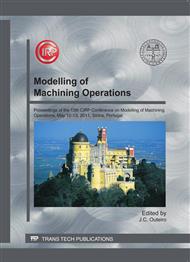p.421
p.431
p.439
p.449
p.456
p.464
p.473
p.483
p.495
High-Speed Milling Characteristics and the Residual Stresses Control Methods Analysis of Thin-Walled Parts
Abstract:
With FEM software of AdvantEdge, a model was created to analyze cutting force and thermal in the high-speed milling process, this model included a complete milling process of cutter radius. Combined with experiments validation, in high-speed milling, the normal force is greater than the tangential force and result in greater residual stress of that direction, which indicates that mechanical force play an essential part on the formation of residual stress. When the speed is over certain scope, the cutting force decreases, but the cutting temperature has been rising. In Roughing, by limiting the range of high-speed the residual tensile stress impact can be reduced. While in finishing, as the feed rate reducing the residual tensile stress will decrease greatly, improving the surface quality of thin-walled parts.
Info:
Periodical:
Pages:
456-463
Citation:
Online since:
April 2011
Authors:
Price:
Сopyright:
© 2011 Trans Tech Publications Ltd. All Rights Reserved
Share:
Citation:


